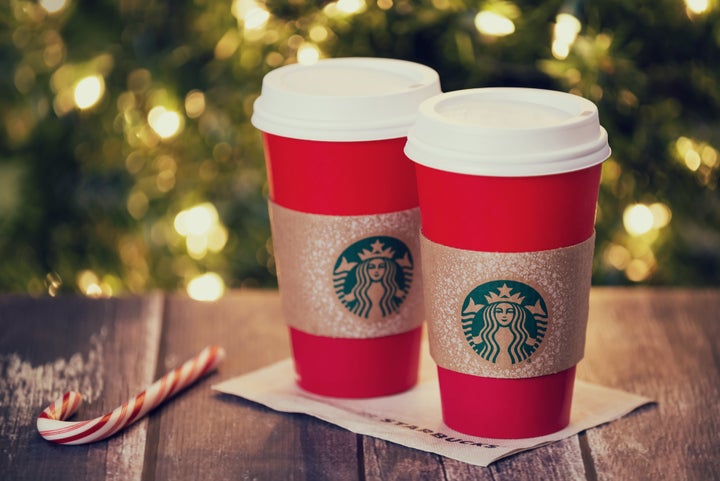It’ll come as no surprise that many of your favourite festive hot drinks are laden with sugar – but it might shock you that in some beverages, there can be as many as 23 teaspoons of the sweet stuff.
A new report from Action on Sugar lays bare just how sugary some Christmas beverages can be – with some increasing in sugar since 2016, against the tide of the government’s sugar reduction programme.
The worst hot chocolate ‘offender’ is Starbucks’ Signature Caramel Hot Chocolate with whipped cream (venti size) using oat milk, according to the report, with 23 teaspoons (93.7g) of sugar and 758 calories.
In second place behind Starbucks’ hot chocolate is Caffe Nero’s Salted Caramel Hot Chocolate (grande) made with skimmed milk, which contains nearly 15 teaspoons of sugar (59.6g) and 503 calories. In contrast, Leon’s Hot Chocolate (regular) has just over four teaspoons of sugar (17g) and 257 calories, demonstrating that lower sugar drinks can be made and enjoyed.
The survey analysed both the sugar and calorie content of the largest available sizes of hot chocolates and seasonal lattes made with milk and milk alternatives (oat, almond, coconut, soya and rice-coconut). It revealed certain seasonal beverages contain almost as much sugar as three cans of Coca Cola.

Starbucks also didn’t fare well in the latte category. Its Gingerbread Latte with oat milk (again, in a venti size) contains more than 14 teaspoons of sugar and 523 calories per portion. The report showed that milk can have a big bearing on sugar content – if the same hot beverage was served with almond milk instead of oat milk, it would reduce the sugar content by 4.5 teaspoons.
Sugar-Filled Hot Chocolates
- Starbucks’ Signature Caramel Hot Chocolate, whipped cream, oat milk (venti), 23 teaspoons of sugar,
- Caffe Nero’s Salted Caramel Hot Chocolate, whipped cream, skimmed milk (grande), 15 teaspoons of sugar,
- Eat’s Honeycomb Hot Chocolate, semi-skimmed milk (regular), 12 teaspoons of sugar,
- Costa’s White Hot Chocolate, semi-skimmed milk (massimo), 11 teaspoons of sugar,
- Pret’s Hot Chocolate with rice-coconut milk (regular), 10 teaspoons of sugar.
Action on Sugar said some businesses like Costa, which has decreased sugar in some products by more than 50% since 2016, are making noticeable progress. However others are “seriously lagging behind” and are “acting completely irresponsibly”, it warned.
Registered nutritionist, Holly Gabriel, said: “It is shocking that so many high street coffee chains are wilfully putting their customers’ health at risk despite PHE [Public Health England] setting sugar reduction targets for sugary milk drinks in 2018.”
She said coffee shops and cafes need to take much greater steps to reduce the levels of sugar and portion sizes, promote lower sugar alternatives and stop pushing “indulgent extras” at the till.
Sugar-Filled Seasonal Lattes
- Starbucks’ Gingerbread Latte, oat milk (venti), 14 teaspoons of sugar,
- Costa’s Hazelnut Praline and Cream, semi-skimmed milk (medio), 8 teaspoons of sugar,
- Creme Brulee Latte, rice-coconut milk (regular), 8 teaspoons of sugar,
- McDonald’s Millionaire Latte, semi-skimmed milk (large), 7 teaspoons of sugar,
- Caffe Nero’s Salted Caramel Latte, skimmed milk (grande), 7 teaspoons of sugar.
A Starbucks spokesperson pointed out that the report reflects the most indulgent customisations a customer can make on the Starbucks menu.
“All our drinks can be customised, such as asking for our smallest size (Short), requesting skimmed milk and less or no whipped cream,” they told HuffPost UK. “To help make it easier for customers to make informed choices, nutritional information is also available in-store, on our mobile app and online.
“We are committed to reducing sugar in all our beverages and since 2015, we’ve delivered a 9% reduction in the sugar content of our Gingerbread and core syrup range of vanilla, caramel and hazelnut.”
The report is timely, coming on the same day that NHS Digital published its Health Survey for England, which showed in 2018, 63% of adults were classified as overweight or obese – 67% of men and 60% of women.
Caroline Cerny, alliance lead at the Obesity Health Alliance, told HuffPost UK the high rates of obesity in adults and children is “sadly reflective of the environment we live in – one that is flooded with unhealthy food and drinks and relentless marketing to tell us to buy and eat more and more”.
“But it doesn’t have to be like this,” she continued. “25 years ago, rates of adult obesity were almost half what they are today. The government can play a vital role in shaping our food environment to help us all be healthy. This is why we need the next government to urgently bring in new regulations to restrict the marketing of junk food and compel the food industry to make everyday food less sugary and calorific.”
